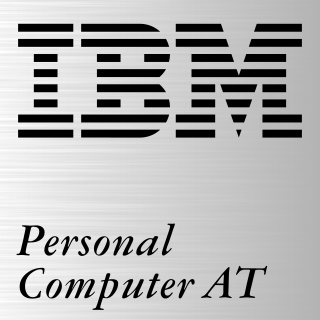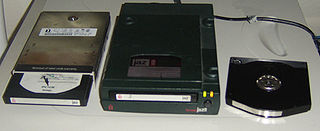
A floppy disk or floppy diskette is a type of disk storage composed of a thin and flexible disk of a magnetic storage medium in a square or nearly square plastic enclosure lined with a fabric that removes dust particles from the spinning disk. The three most popular floppy disks are the 8-inch, 5¼-inch, and 3½-inch floppy disks. Floppy disks store digital data which can be read and written when the disk is inserted into a floppy disk drive (FDD) connected to or inside a computer or other device.

A hard disk drive (HDD), hard disk, hard drive, or fixed disk is an electro-mechanical data storage device that stores and retrieves digital data using magnetic storage with one or more rigid rapidly rotating platters coated with magnetic material. The platters are paired with magnetic heads, usually arranged on a moving actuator arm, which read and write data to the platter surfaces. Data is accessed in a random-access manner, meaning that individual blocks of data can be stored and retrieved in any order. HDDs are a type of non-volatile storage, retaining stored data when powered off. Modern HDDs are typically in the form of a small rectangular box.

The IBM Personal Computer AT was released in 1984 as the fourth model in the IBM Personal Computer line, following the IBM PC/XT and its IBM Portable PC variant. It was designed around the Intel 80286 microprocessor.

The Jaz drive is a removable hard disk storage system sold by the Iomega company from 1995 to 2002.

The ProFile is the first hard disk drive produced by Apple Computer, initially for use with the Apple III personal computer. The original model had a formatted capacity of 5 MB and connected to a special interface card that plugged into an Apple III slot. In 1983, Apple offered a ProFile interface card for the Apple II, with software support for Apple ProDOS and Apple Pascal.

The Rainbow 100 is a microcomputer introduced by Digital Equipment Corporation (DEC) in 1982. This desktop unit had a monitor similar to the VT220 and a dual-CPU box with both 4 MHz Zilog Z80 and 4.81 MHz Intel 8088 CPUs. The Rainbow 100 was a triple-use machine: VT100 mode, 8-bit CP/M mode, and CP/M-86 or MS-DOS mode using the 8088. It ultimately failed to in the marketplace which became dominated by the simpler IBM PC and its clones which established the industry standard as compatibility with CP/M became less important than IBM PC compatibility. Writer David Ahl called it a disastrous foray into the personal computer market. The Rainbow was launched along with the similarly packaged DEC Professional and DECmate II which were also not successful. The failure of DEC to gain a significant foothold in the high-volume PC market would be the beginning of the end of the computer hardware industry in New England, as nearly all computer companies located there were focused on minicomputers for large organizations, from DEC to Data General, Wang, Prime, Computervision, Honeywell, and Symbolics Inc.
Conner Peripherals, Inc., was a company that manufactured hard drives for personal computers. Conner Peripherals was founded in 1985 by Seagate Technology co-founder and San Jose State University alumnus Finis Conner. In 1986, they merged with CoData, a Colorado start-up founded by MiniScribe founders Terry Johnson and John Squires. CoData was developing a new type of small hard disk that put the capacity of a 5.25-inch drive into the smaller 3.5-inch format. The CoData drive was the first Conner Peripherals product. The company was partially financed by Compaq, who was also a major customer for many years.
Pertec Computer Corporation (PCC), formerly Peripheral Equipment Corporation (PEC), was a computer company based in Chatsworth, California which originally designed and manufactured peripherals such as floppy drives, tape drives, instrumentation control and other hardware for computers.

In 1953, IBM recognized the immediate application for what it termed a "Random Access File" having high capacity and rapid random access at a relatively low cost. After considering technologies such as wire matrices, rod arrays, drums, drum arrays, etc., the engineers at IBM's San Jose California laboratory invented the hard disk drive. The disk drive created a new level in the computer data hierarchy, then termed Random Access Storage but today known as secondary storage, less expensive and slower than main memory but faster and more expensive than tape drives.

Hardcard is the genericized trademark for a hard disk drive, disk controller, and host adapter on an expansion card for a personal computer.

The APC was a series of business microcomputers released outside of Japan by the NEC Corporation. The series comprised the APC, the APC II and APC III, international versions of models from the Japanese NEC N5200 series(jp).
Core International, Inc., commonly referred to as Core, was a multinational computer and technology corporation headquartered in Boca Raton, Florida, United States.

Plus Development Corporation was a majority-owned subsidiary of Quantum Corporation. The company invented the Hardcard, a hard disk drive on an expansion card, which started a wave of companies producing similar products in the 1980s.
The Tandon Corporation was an American disk drive and PC manufacturer founded in 1975 by Sirjang Lal Tandon, a former mechanical engineer. The company originally produced magnetic recording read/write heads for the then-burgeoning floppy-drive market. Due to the labor-intensive nature of the product, production was carried out in low-wage India where production costs were lower. This was the key to the company's competitiveness. In the late 1970s, Tandon developed direct equivalents to Shugart floppy drives, and is credited with the invention of DS/DD versions which became its primary product in the early 1980s.

The floppy disk is a data storage and transfer medium that was ubiquitous from the mid-1970s well into the 2000s. Besides the 3½-inch and 5¼-inch formats used in IBM PC compatible systems, or the 8-inch format that preceded them, many proprietary floppy disk formats were developed, either using a different disk design or special layout and encoding methods for the data held on the disk.

The IBM Personal Computer XT is the second computer in the IBM Personal Computer line, released on March 8, 1983. Except for the addition of a built-in hard drive and extra expansion slots, it is very similar to the original IBM PC model 5150 from 1981.
Tallgrass Technologies Corporation was an American computer hardware company that was the first to offer a hard disk drive product for the IBM PC in 1981. Tallgrass was a Kansas City based microcomputer hardware and software company founded in December 1980 by David M. Allen. The hard disk drive product was initially sold in Computerland stores, alongside the original IBM PC. Tallgrass added tape-backup systems to its product line in 1982.
The Tandy 3000 is a personal computer introduced by Radio Shack in 1986 based on the 16-bit 8 MHz Intel 80286 microprocessor.

















